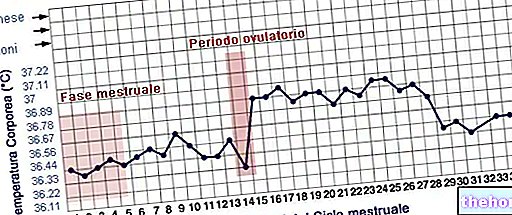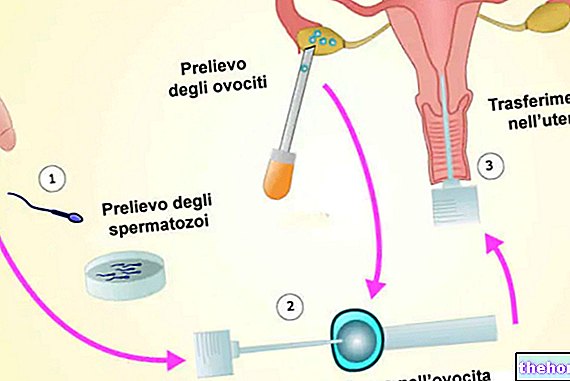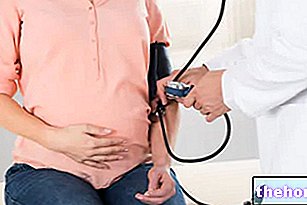Definition
As the word itself anticipates, gestational hypertension consists of an increase in blood pressure that occurs during pregnancy; generally, the increase in blood pressure begins after the 20th week of gestation and disappears after delivery.
- In the first months of pregnancy there is an opposite event (physiological reduction of blood pressure)
Causes
A "single cause implicated in the manifestation of" hypertension in pregnancy has not yet been identified with certainty; in any case, the association of several factors could heavily affect the onset of the disorder: low-calorie diet low in calcium, zinc and proteins, alterations in the immune system, genetic predisposition, malfunction of the placenta.
- Risk factors: age under 20 or over 35, multiple pregnancies, first pregnancy, genetic predisposition
Symptoms
Symptoms accompanying gestational hypertension can be expressed in: decrease in the amount of urine, abdominal pain, swelling of the face and ankles, severe headache, systolic blood pressure increase greater than 25-30 mmHg (compared to conception), increase diastolic blood pressure above 15mmHg (compared to conception), urinary loss of protein (preeclampsia), blood pressure above 140 / 90mmHg, tiredness, vomiting.
The information on Hypertension in Pregnancy - Medicines for the Treatment of Gestational Hypertension is not intended to replace the direct relationship between health professional and patient. Always consult your doctor and / or specialist before taking Hypertension in Pregnancy - Medication for Treatment of gestational hypertension.
Medicines
Arterial hypertension is a rather dangerous condition, since it can cause serious consequences to the unborn child, such as stunted growth and neonatal mortality; therefore, blood pressure monitoring and urinalysis are two indispensable preventive strategies during pregnancy.
Before embarking on a therapeutic-pharmacological path, it is essential to take into account some distinct elements:
- Possibility of the risks of the fetus
- Need to decrease the blood pressure of the pregnant woman
- Distinguish chronic hypertension (already present at conception) from gestational hypertension (which occurred after the 20th week)
If gestational hypertension is diagnosed, bed rest is useful for reducing peripheral vasoconstriction and improving utero-placental flow.
The following are the classes of drugs most used in the therapy against gestational hypertension, and some examples of pharmacological specialties; it is up to the doctor to choose the most suitable active ingredient and dosage for the patient, based on the severity of the disease, the state health of the patient and his response to treatment:
It is recommended to start therapy for the treatment of gestational hypertension when the minimum blood pressure (diastolic) values exceed 100-105 mmHg; in order to avoid eclampsia, it is recommended to lower the blood pressure if the values exceed 170/110 mmHg.
If the diastolic pressure was between 90 and 99 mmHg, behavioral therapy is generally sufficient to bring blood pressure values to normal:
- reduce body weight if necessary
- avoid eating foods rich in sodium
- avoid overexertion
- do not drink alcohol
- not smoking
- drink a lot of water
- Alpha-Methyldopa (eg Aldomet): centrally acting antihypertensive, used during pregnancy because it is safe. It is recommended to start therapy with a drug dose of 250 mg, to be taken orally 2-3 times a day; alternatively, 250-500 mg can be taken as a slow 30-60 minute infusion every 6 hours. Do not exceed 3 grams per day. The maintenance dose involves taking 500 mg of active (max. 2 g), divided into 2-4 doses, up to a maximum of 3 grams per day. The drug can also be used for the treatment of hypertensive crises during gestation: in this case, it is recommended to take 250-500 mg of active, by slow infusion of 30-60 minutes, every 6 hours, until blood pressure returns to physiological values.
- Nifedipine (eg. Adalat): the active ingredient (calcium antagonist) is generally available in slow-release tablets: it is however a second choice drug for the treatment of gestational hypertension. Indicatively, start administering the drug with a dose of 30-60 mg, orally The dosage can be changed every 7-14 days.
- Labetalol (eg Ipolab, Trandate, Trandiur): indicated for the control of hypertensive crises. The drug is usually given intravenously, although it is sometimes taken by mouth. For the treatment of hypertensive crises in pregnancy, it is recommended to take the drug at a dose of 20 mg by intravenous injection (2 minutes); after 10 minutes, the drug can be given again by IV injection. (dose of 40-80 mg). Do not exceed 300 mg of active. Generally, the maximum therapeutic effect occurs 5 minutes after administration. Orally, take 100 mg of drug twice a day; follow therapy with a dose of 200-400 mg of drug, twice a day.
- Hydralazine (eg Presfylline): this antihypertensive drug, like the previous one, is also administered intravenously and is indicated to control hypertensive crises. In such situations, it is recommended to take 20-40 mg of active intravenously or intramuscularly, as needed. Consult your doctor. Currently, the drug is neither produced nor marketed in Italy.
- Clonidine (eg Catapresan, Isoglaucon): the drug is an agonist of imidazoline receptors, indicated both for the treatment of chronic hypertension and for the gestational form. Indicatively, start therapy with ½ or 1 tablet of 150 mcg. The dosage must be fine-tuned by the physician.
- Magnesium sulphate (eg Magne So BIN, Magne So GSE): represents the drug useful in the prevention of eclampsia, in which gestational hypertension is a characteristic symptom. The dosage should be established by the doctor.
Administration of beta blockers for blood pressure reduction during gestation is only possible from the third month on.
Women with chronic hypertension, even before pregnancy, should pay particular attention to the administration of diuretics, sartans and ACE inhibitors, given the possible complications deriving from the administration of these drugs, both for the mother and for the unborn child.









.jpg)


















